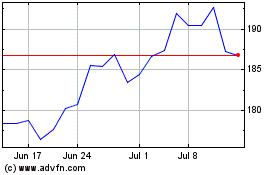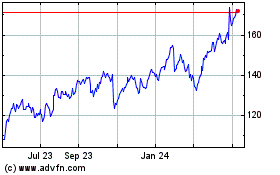Artificial Intelligence Systems Manage More Complex Tasks
October 12 2016 - 1:33PM
Dow Jones News
By Daniela Hernandez
Artificial-intelligence systems can do increasingly complex
tasks but they can't yet figure much out on their own without help
from humans.
In a paper published Wednesday in the journal Nature,
researchers at Alphabet Inc.'s Google DeepMind describe
experimental software that they say gets closer to that goal and
could be more accurate and less costly than current systems.
Their prototype learned to navigate the London Underground and
plan the shortest route to a destination. It could also figure out
how imaginary people were related. For both challenges, it drew on
and retained knowledge it had learned previously, suggesting that
the new technology could learn from experience, according to Alex
Graves, a DeepMind research scientist and one of the study's lead
authors.
"There's a lot of things it could be used for," he said. One
obvious future application is "chatbots," software that answers
questions autonomously, he said.
The new DeepMind prototype couples so-called artificial neural
networks -- which are widely used for image and speech recognition
-- with an external memory. Data can be read from and written to
memory, like in a traditional computer. Dr. Graves likened it to a
scratchpad a person could write on, reference and update as he or
she made decisions and learned new facts.
The researchers trained their software, dubbed a differentiable
neural computer, to answer questions, solve a simple puzzle, and
optimize subway rides. Its error rate in the question-answer test
was 3.8%, according to the paper.
The new DeepMind prototype outperformed more traditional neural
networks, but required half as many examples to learn, according to
the study. Data is among the most expensive ingredients needed to
train algorithms.
Current artificial neural networks can retain only small amounts
of information as they scan data. This limits their ability to
perform tasks that require long-term planning or historical
knowledge, like navigating new environments without a human teacher
or engaging in nuanced conversations peppered with jokes and
cultural references.
"Right now, that's beyond reach," said Bruno Olshausen, the
director of the University of California, Berkeley's Redwood Center
for Theoretical Neuroscience. "With memory, you're giving it a leg
up. ... It's still a long ways off. [But] you're one step closer to
a truly autonomous system." Dr. Olshausen wasn't involved with the
new work.
Over the past two years, the field of memory-augmented neural
networks has blossomed, according to artificial-intelligence
experts.
In late 2014, DeepMind unveiled so-called Neural Turing
Machines, a similar, but less flexible, technology than the new
prototype system. Soon after, Facebook Inc. researchers published a
paper describing Memory Networks, a system also coupled to an
external memory. A spokesman for Facebook declined to comment.
These evolved from a special breed of software called long
short-term memory networks that have a short-lived built-in memory.
Such systems already power real-world applications like voice
search and automated transcription.
But systems with external memories like DeepMind's neural
computer haven't yet busted out of the lab, and much work likely is
still necessary to make them commercially relevant, said Yoshua
Bengio, the director of the University of Montreal's Montreal
Institute for Learning Algorithms, who does research in this area
but wasn't involved in developing the new neural computer.
The DeepMind team doesn't yet know what steps they'll take next
to further develop the technology, said Dr. Graves. "We're doing
academic research here," he said. "But we're confident it will be
useful in the future."
Write to Daniela Hernandez at daniela.hernandez@wsj.com
(END) Dow Jones Newswires
October 12, 2016 13:18 ET (17:18 GMT)
Copyright (c) 2016 Dow Jones & Company, Inc.
Alphabet (NASDAQ:GOOG)
Historical Stock Chart
From Mar 2024 to Apr 2024

Alphabet (NASDAQ:GOOG)
Historical Stock Chart
From Apr 2023 to Apr 2024
